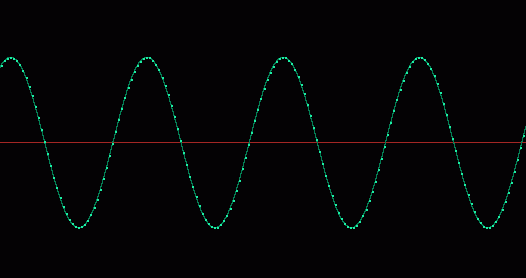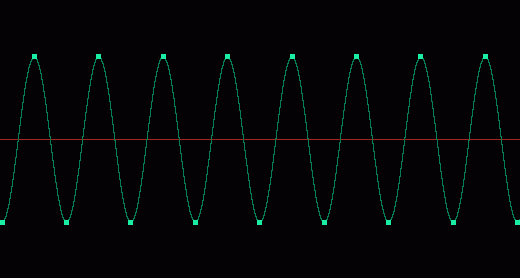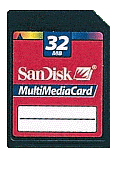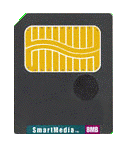|
MP3 Files and Players
Note:
This was written a long time ago and things changed quickly so look at this as a historical document, much like my computer site.
An MP3 file is an audio file that's been converted from analog to digital format. The files are typically a fraction of the size of the original wav file which makes them popular with portable audio players like the iPod.
WAV files:
Before MP3 files are covered in detail, you need to understand why they're needed. Wav Files are raw data files that have information that's sampled a predetermined number of times per second. Digital audio such as that used on CDs is sampled at 44,100 times per second with 16 bit samples. This means that a sample is taken 44,100 times per second and each sample has 16 pieces of information. Since we need at least 1 sample from each half of the waveform at all frequencies to reproduce the audio signal, we need at least a 40,000 samples per second to reproduce a 20,000 hertz signal (the upper end of the audio band). A sampling rate of 44.1khz allows us to reproduce the entire audio spectrum (20-20,000 hertz). Lower sampling rates and lower bit rates allow smaller data files but will also reduce the maximum reproducible frequency and resolution. Wav files can be used on a web site (I have a few on this site) but the download times can be quite long. To transmit a CD quality stereo signal in real time, it would require a transfer rate of more than 1.4 million bits per second. This is a significantly higher bit rate than can be achieved on the net.
The image below is a 1000hz signal recorded at 44,100 samples per second. The bright green dots are the points where the data samples were taken on the waveform. This is less than 0.005 seconds of audio.

This is a 22,050hz signal sampled at 44,100hz. You can see that there is exactly 2 samples/cycle. One for each half of the waveform.

MP3 files:
Long, long ago in a lab far, far away... Well, it wasn't so long ago nor so far away but... a group of experts (let's call them the Motion Picture Experts Group) decided that there was a need to have a quality audio compression scheme that would allow a virtually lossless audio compression. There have been several predecessors of the current MPEG-1 Layer-3 or MP3 format. The MP3 format allows CD quality audio to be coded with a 12:1 reduction in file sizes when compared to a wav file.
The Layers:
Layer-1 audio coding is the simplest coding scheme. It allows the least amount of file compression (up to 4:1 for a CD quality recording) but requires the least processor power. Layer-2 allows better compression (up to 8:1 for CD quality recordings). Layer-2 requires still more processor power to decode the signal in real time. Layer-3 coding is the coding scheme with which we are all familiar. It allows a file reduction of as much as 12:1 for CD quality recordings.
Note:
There are other MPEG formats such as MPEG-2 and MPEG-4. Both have 3 layers.
Perceptual Coding:
As you know, the human auditory system has a very large range dynamic range. We can hear a pin drop or a dragster blasting down the track. One thing it can't do is hear the pin drop while the dragster is making all of that noise. This 'masking' (by our auditory system) of the quieter sounds while there are louder sounds is what helps to make MP3 so effective. The MP3 encoder discards all of the material which is not going to be heard by our auditory system. When done properly, what's left is all that we would hear anyway.
Joint Stereo:
In stereo audio, there are sounds that are in both channels equally. MP3 encoding takes advantage of this to further reduce the file size. There's no point in making 2 copies of the same material.
Huffman Coding:
Huffman coding is an algorithm that allows further compression of sounds that have little masking such as pure tones.
Bit rates:
MP-3 files can be recorded at different rates. If you only want a telephone quality mono signal, the file size can have a 96:1 reduction. If you require a CD quality stereo signal, you'll have to record at a higher bit rate such as 128kbps which still allows a file size reduction of ~12:1.
If you want or need even more detailed information try this site or this site.
Virtually everything below this point is old information and generally useless. This page will be updated soon to reflect more current equipment.
Player and Media Types
Multi-Media Card Players:
Multi-Media Card (MMC) players accept a media card that's 24mm x 32mm x 1.4mm. they're readily available in sizes up to 128GB.

Smart Media Card Players:
Smart-media card players accept a memory card that's 37mm x 45mm x 0.76mm.

Compact Flash Card Players:
There are some players that read from Compact Flash cards (memory cards used in, among other things, digital cameras and PDAs). The dimensions of a compact flash card is 3.3mm x 43mm x 36mm. They're available in capacities up to 2GB. There is at least one in dash player (the Clarion autoPC) that uses this type of storage device. The Clarion autoPC can also accept the IBM microdrive*. The IBM microdrive is a very small (5mm x 43mm x 36mm) hard drive that fits into the same port as a compact flash card. At this time the microdrive is available in sizes up to 1 gigabyte and cost about. At this time, the 1 gig drive is ~$400us. The Compact Flash cards are approximately $1.5/meg.
*IBM's hard drive division was purchased by Hitachi. They are supposed to produce a 4GB microdrive in the near future (if it's not already on the market).

Compact Disc Type Players:
This type of player is generally a dual format player. There are at least 2 different models available (Aiwa and Kenwood). You can see them on the Crutchfield site. They can play normal CDs which make them very popular. They can also play CDRs with MP3 files. This allows you to record MP3 files from your computer if you have a CD burner. Since CDRs are extremely inexpensive, this can be a really cost effective way to play MP3 files (ignoring the cost of the computer, CD burner and the deck, of course :-)
Hard Drive Based Players:
This type of player is similar to your PC. It reads the files from a hard drive similar to what's in your computer. Players (like the empeg/Rio player) are available with different size hard drives. You can load files from your computer through several different types of ports (serial, USB, ethernet). This type of player goes in the dash of your vehicle just as a standard head unit. The empeg/Rio player runs the Linux operating system.
USB Port:
A USB (universal serial bus) port is a new type of port that allows many different types of peripherals to be connected to your computer. Many of the new digital cameras, modems, printers, scanners and drives (just to name a few) use USB ports. USB can transfer data at rates between 1.5 and 12 Mbps. The interconnect cable largely determines the actual transfer rate. For more info on USB ports, visit this site.
Serial Port:
The serial port can be either a 9 pin or 25 pin connector. The data transfer in either form is the same. This type of connector is used to connect to your mouse or external modem. The serial port has a maximum transfer rate of ~250kbps.
Parallel Port:
The parallel port on the back of your computer can transfer data on 8 pins at a time which makes it able to transfer data faster than a standard serial port. The connector is a 25 contact connector which has 25 sockets to accept the 25 pins on the interconnect cable. This is the connector you might use for your printer (or other peripherals).
Ethernet Port:
An ethernet port is capable of 10Mbps. It was designed for use with Local Area Networks. It can be transmitted through fiber optics, coaxial or even twisted pair telephone cable. The connector for twisted pair cabling is an RJ45, 8 conductor telephone type plug/jack.
Linux:
Linux is an open source computer operating system originally conceived by Finish programmer Linus Torvalds. The system will, hopefully, come to replace Windows as the main operating system for PCs (or at least force Windows build an operating system that doesn't crash during normal use). The biggest advantage of Linux is the fact that it's an open source program which means that anyone (programmers) can write, edit or otherwise modify the operating system to best fit their needs.
Portables (other):
At least one type of portable (the Rave) uses an Iomega Clik! disc. The Clik! disc holds 40 megs of data which translates into approximately 40 minutes of CD quality music. This is a relatively cost effective type of removable storage because the discs are only about $10 at the time this page was written (March 2001).

Adapters/converters/cables:
There are several different types of adapters to connect portable MP3 players to your audio system.
- The worst type (in my opinion) is the cassette adapter. It looks like a cassette tape and goes into your cassette player just like a cassette tape. It has a wire with a mini phone plug on it that plugs into the headphone jack of your portable MP3 player. This type of adapter will provide the poorest sound quality of all.
- Another type of adapter is the RF modulator. It goes into the antenna line for you head unit. It accepts an audio signal (from the headphone output of your MP3 player) and converts it to an FM signal that can be received by your head unit. They generally have 2 different frequencies. You tune your head unit to the selected frequency to listen to the MP3s. The sound quality with this type of adapter will provide surprisingly good sound quality (generally better than FM stations).
- The last is not so much a converter but a cable. It would have a stereo mini phone jack on one end and a set of RCA cables on the other end. It's used to connect the MP3 player to the RF converter or an EQ with a front panel auxiliary jack.
|






